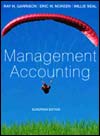 |
1 |  | 
One of the following is a relevant cost to the decision to build a factory
(Learning Objective 1 Ch 9) |
|  | A) | The cost of a survey that has already been paid for |
|  | B) | The government grant available |
|  | C) | The land owned by the company on which the factory would be built |
|  | D) | The cost of the existing factory on that site |
 |
 |
2 |  | 
One of the following types of cost is an irrelevant cost
(Learning Objective 1 Ch 9) |
|  | A) | Future costs that differ between alternatives |
|  | B) | Unavoidable cost |
|  | C) | Differential cost |
|  | D) | Sunk cost |
 |
 |
3 |  | 
One of the following statements is true when considering replacing old equipment
(Learning Objective 2 Ch 9) |
|  | A) | We must recover the written down value of an asset in the balance sheet |
|  | B) | We must ignore the greater capacity of the new machine. |
|  | C) | We must take into consideration the depreciation rates on the old machine |
|  | D) | We must take into account the useful life of the new machine |
 |
 |
4 |  | 
One of the following statements is true
(Learning Objective 1 Ch 9) |
|  | A) | Costs used in financial accounts will always be relevant to any decision |
|  | B) | If costs are relevant to one decision then they will be relevant to all decisions |
|  | C) | Different costs should be used for different purposes |
|  | D) | Costs used for product pricing purposes will always be relevant to any decision |
 |
 |
5 |  | 
The WDV of an old widget machine is £200,000. The scrap value of this old machine is £50,000. The Cost of a new widget machine is £500,000. The costs of producing widgets with the new machine will be £80,000 cheaper per year. The life of the new machine will be 6 years. The fixed costs are £20,000 per year. Ignore the time value of money. The differential benefit/ (cost) of the new machine will be
(Learning Objective 2 Ch 9) |
|  | A) | 30,000 |
|  | B) | (170,000) |
|  | C) | (290,000) |
|  | D) | 80,000 |
 |
 |
6 |  | 
When debating whether to drop a product line one of the following items should be ignored
(Learning Objective 3 Ch 9) |
|  | A) | The contribution from each of the products |
|  | B) | The shared fixed costs of all the product lines |
|  | C) | The possible replacement products |
|  | D) | The individual fixed costs (not including depreciation) of each of the product lines |
 |
 |
7 |  | 
A company is thinking of buying in an assembly that it currently makes. The cost of buying it in would be £13. The unit costs of making the assembly are Material £3, Labour £6, Variable Overhead £2, Depreciation of equipment £2, Apportioned overheads £1. The equipment used has no scrap value. Calculate the differential benefit/ (cost) of buying the assembly in.
(Learning Objective 4 Ch 9) |
|  | A) | nil |
|  | B) | (£1) |
|  | C) | (£2) |
|  | D) | (£4) |
 |
 |
8 |  | 
Same information as Q7 but if the assembly is bought in equipment could be used for making another product with a contribution of £4 per unit. Calculate the differential benefit/ (cost) of buying the assembly in.
(Learning Objective 4 Ch 9) |
|  | A) | The answer would be the same as Q7 |
|  | B) | £6 |
|  | C) | (£8) |
|  | D) | £2 |
 |
 |
9 |  | 
A firm make dresses. The material and labour cost of producing each dress is £4. The fixed cost apportioned to each dress is £5. The current price each dress is sold for is £12. A special order is comes in and the buyer wants to pay £7. One of the following statements is true
(Learning Objective 5 Ch 9) |
|  | A) | The order should be rejected, as the price is less than the normal price |
|  | B) | The order should be rejected, as the price is less than the absorption cost |
|  | C) | The order should be accepted as we would be making a gain of £3 per dress. |
|  | D) | The order should be accepted as we would be making a gain of £8 per dress. |
 |
 |
10 |  | 
The firm in Q9 taking the decision should not consider one of the following factors
(Learning Objective 5 Ch 9) |
|  | A) | The market that the buyer under the special order will sell the dresses. |
|  | B) | The shared fixed costs with another product |
|  | C) | The firm’s spare capacity |
|  | D) | Whether the people making the dresses are paid a weekly wage or are on piece work. |
 |
 |
11 |  | 
One of these statements will be true when considering the profitable use of a constrained resource
(Learning Objective 6 Ch 9) |
|  | A) | The manager should select the course of action that maximises the total contribution margin |
|  | B) | The manager should select the course of action that maximises the profit of the firm |
|  | C) | The manager should select the course of action that minimises the fixed costs |
|  | D) | The manager should select the course of action that maximises the sales |
 |
 |
12 |  | 
There is a shortage of machine hour. The contribution per machine hour of each of the products below is as follows, What order should they be made in?  <a onClick="window.open('/olcweb/cgi/pluginpop.cgi?it=gif::_::/sites/dl/free/0077098595/74294/09_12q.gif','popWin', 'width=NaN,height=NaN,resizable,scrollbars');" href="#"><img valign="absmiddle" height="16" width="16" border="0" src="/olcweb/styles/shared/linkicons/image.gif">_ (0.0K)</a>_ <a onClick="window.open('/olcweb/cgi/pluginpop.cgi?it=gif::_::/sites/dl/free/0077098595/74294/09_12q.gif','popWin', 'width=NaN,height=NaN,resizable,scrollbars');" href="#"><img valign="absmiddle" height="16" width="16" border="0" src="/olcweb/styles/shared/linkicons/image.gif">_ (0.0K)</a>_
(Learning Objective 6 Ch 10) |
|  | A) | A B C D |
|  | B) | D C B A |
|  | C) | We cannot tell |
|  | D) | All of them should be made |
 |
 |
13 |  | 
The following data relates to Q13 – 18 and to a factory where there are only 10,000 labour hours.  <a onClick="window.open('/olcweb/cgi/pluginpop.cgi?it=gif::_::/sites/dl/free/0077098595/74294/09_13_18q.gif','popWin', 'width=NaN,height=NaN,resizable,scrollbars');" href="#"><img valign="absmiddle" height="16" width="16" border="0" src="/olcweb/styles/shared/linkicons/image.gif">_ (1.0K)</a>_ <a onClick="window.open('/olcweb/cgi/pluginpop.cgi?it=gif::_::/sites/dl/free/0077098595/74294/09_13_18q.gif','popWin', 'width=NaN,height=NaN,resizable,scrollbars');" href="#"><img valign="absmiddle" height="16" width="16" border="0" src="/olcweb/styles/shared/linkicons/image.gif">_ (1.0K)</a>_
What order should they be made in?
(Learning Objective 6 Ch 10) |
|  | A) | A B C D |
|  | B) | D C B A |
|  | C) | C D A B |
|  | D) | B A D C |
 |
 |
14 |  | 
How many should be made of product C
(Learning Objective 6 Ch 10) |
|  | A) | 6,000 |
|  | B) | 1,000 |
|  | C) | none |
|  | D) | 15,000 |
 |
 |
15 |  | 
How many should be made of product D
(Learning Objective 6 Ch 10) |
|  | A) | 6,000 |
|  | B) | 1,000 |
|  | C) | none |
|  | D) | 15,000 |
 |
 |
16 |  | 
How many should be made of product A
(Learning Objective 6 Ch 10) |
|  | A) | 6,000 |
|  | B) | 1,000 |
|  | C) | none |
|  | D) | 15,000 |
 |
 |
17 |  | 
How many should be made of product B
(Learning Objective 6 Ch 10) |
|  | A) | 6,000 |
|  | B) | 1,000 |
|  | C) | none |
|  | D) | 15,000 |
 |
 |
18 |  | 
One of the following statements is untrue when considering whether joint products should be sold at the split off point or processed further?
(Learning Objective 7 Ch 10) |
|  | A) | All costs up to the point of split off should be ignored |
|  | B) | All costs after the point of split off should be considered |
|  | C) | Depreciation should always be ignored |
|  | D) | Allocated costs are always important |
 |




 2003 A McGraw-Hill Online Learning Centre
2003 A McGraw-Hill Online Learning Centre